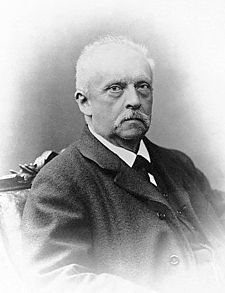The term irradiation illusion was coined by German scientist Hermann von Helmholtz in the 1860s to describe the visual perception in which a light area appears larger than an identically-sized dark area. The effect was observed as early as the time of Galileo, who refers to it in his observations of the sizes of planets when viewed through a telescope at different times of day. The illusion is illustrated below. The white square in the black field on the right seems larger than the black square in the white field on the left. It’s as if the white area on the right spills outward beyond its edges into the surrounding black. At the same time, the white field on the left appears to encroach upon the black square making it shrink.

The drawing below shows how the irradiation illusion can affect lettering. The top halves of the letters shown are clearly bolder looking than the bottom halves. This means that, on a dark background, a white letter with a heavy stroke will look even heavier, sometimes to the point that legibility is compromised. Counter spaces that are already small become even smaller. Interletter spacing shrinks. Heavy white lettering on a dark background can take on an unpleasant bloated look, and the effect is more pronounced as the viewing distance increases. The solution, simply, is to use lighter stroked letters and increase the letter spacing when the background is dark.

This phenomenon of white letters appearing heavier is not always a bad thing. The effect can be put to use at times. It can even save an otherwise weak layout. How so?
Put the Irradiation Illusion to good use
Computer font collections tend to have a disproportionately high number of light faced letter styles. These typestyles are designed mostly for print, not for signs. Times Roman, as an example, is an inherently weak letter style on sign work. It looks fine in print, up close. After all, it was designed for newspapers held at arm’s length, paper whose porous qualities actually help thin-faced letters. Paper, especially newsprint, allows inked letters to bleed a little through capillary action (the printer’s term for this is dot gain). This effect allows the hairline strokes characteristic of many romans to achieve a little more thickness when printed. But in large sizes on signs, the thin strokes of painted or vinyl lettering remain thin lines. Add to this thinness the effect of the irradiation illusion, and the strokes become even thinner. The result is that a large sign lettered in all Times Roman has a distinctly anemic look. In printspeak, the lettering is not ‘black’ enough. It appears insubstantial, weak. The thinnest strokes eventually disappear as viewing distance increases, leaving visible only a series of meaningless vertical strokes. But if you create a reversed color scheme—putting white roman letters on a black background—the letters instantly become a little stronger.
Similarly, the legibility of some scripts can be improved by a dark background. Computer scripts are often so light faced as to be useless for sign work without some kind of ‘stroking’ to beef them up. Using a dark background can sometimes solve the problem with minimal effort.
Before computer fonts
In the days of painted signs, the expanding/shrinking illusion of irradiation was a problem easily addressed. For one thing, sign painters did not use fonts [related post: Sign painters didn’t use fonts], so they were not burdened with picking through hundreds of unusable typestyles to find the few that worked well. Their letter styles, “alphabets,” as they called them, were all hand drawn specifically for sign work. Generally, these styles were not duplicates of typestyles that were created for print. And letterers tended to rely on medium and medium-heavy stroke weights for the bulk of their work. When a light typestyle was required, say, by an insistent client, or when an architect specified a certain typeface, it was easy to thicken the strokes slightly if needed for legibility. This could even be done on the fly during the brush lettering process. When a sign painter used script, it was most often a medium weight, sometimes heavy, infrequently light. Experienced sign painters knew that light faced lettering often produced weak-looking signs that lacked impact.
Good design is rarely accidental
In sign design, legibility is dependent on the interplay of light and dark images. Letter recognition relies not only on the positive image of the letterform but also on the negative space surrounding and within it. When one or the other is overpowering, there is always a compromise of legibility. This is why medium weight letters tend to be the most legible on sign work. It doesn’t mean heavy or light faced letters should not be used at all. Rather, it means using them prudently.
Being aware of, and carefully manipulating, effects like the irradiation illusion can help a sign artist produce good layout. Effective design is not an accident.
………………..
My inspiration for this article is an archived blog by UK designer and typographer Jon Tangerine from 2010: jontangerine.com
………………..
Hermann von Helmholtz

Hermann von Helmholtz bio in brief. from famousscientists.org
Hermann von Helmholtz bio from Encyclopedia Britannica. His pursuits as a scientist were broad. Perhaps best known for his invention of the ophthalmoscope in 1861, still an essential diagnostic tool used in medicine today.
Hermann von Helmholtz from the Stanford Encyclopedia of Philosophy. Details of his interests, philosophies, teachings and accomplishments.


 Vertically stacked letters, a common treatment a century ago, is not a preferred layout technique for sign work.
Vertically stacked letters, a common treatment a century ago, is not a preferred layout technique for sign work.










